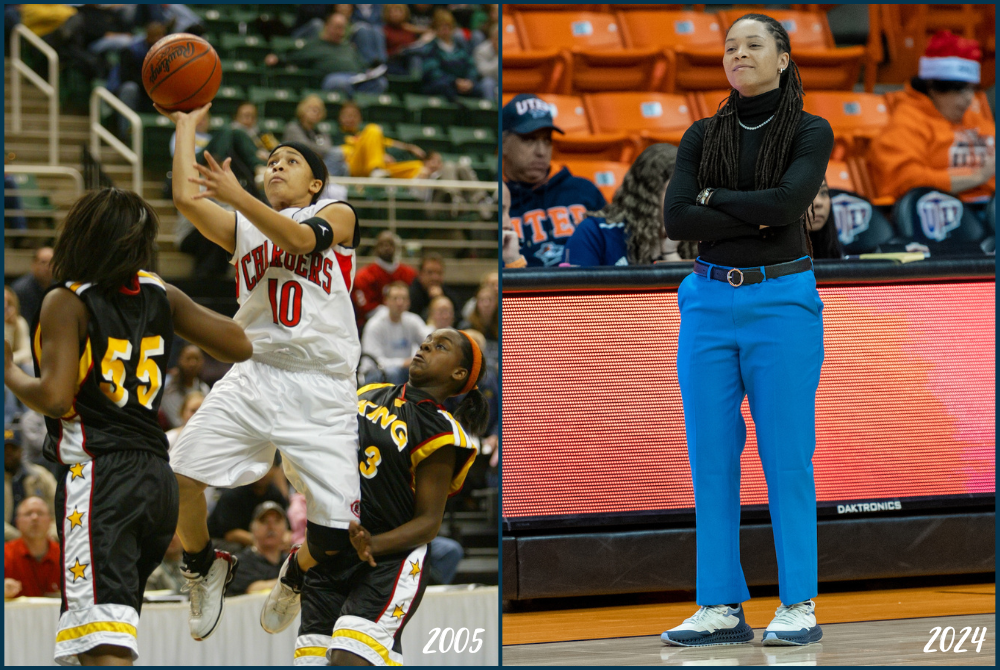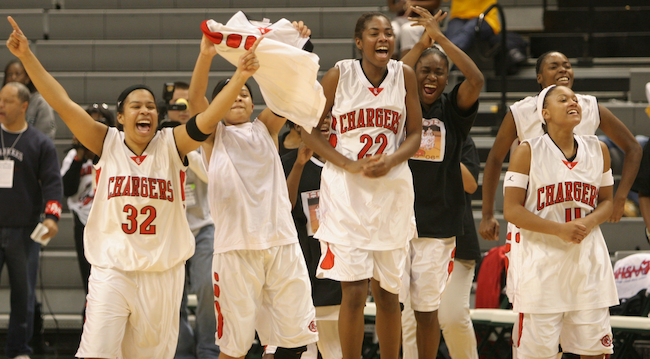
Schools Continue to Manage the Heat
July 16, 2015
By Rob Kaminski
MHSAA benchmarks editor
It certainly was not the MHSAA’s intent to spur the most historically frigid back-to-back winters the state has seen. Nor did the Association wish for one of the mildest summers in recent memory during 2014.
Seemingly, it’s just Mother Nature’s way of reading into MHSAA efforts for managing heat and humidity and acclimatizing student-athletes for warm-weather activities.
Since guidelines were put in place (recommended for regular-season sessions and required for postseason tournaments) before the 2013-14 school year, there have been relatively few days during which psychrometers have had to be implemented.
“The key is, we’ve got plans in place for when the climate returns to normal trends for return-to-school practices and contests in August and September, as well as early June events,” said MHSAA Executive Director Jack Roberts. “It is a bit ironic that there have been relatively few days since the guidelines were established that they’ve actually come into play.”
In a nutshell, the guidelines provide instruction for four ranges of heat index: below 95 degrees; 95-99 degrees; 99-104 degrees, and heat indexes above 104 degrees, with increasing precautions in place as heat indexes rise. An index above 104 calls for all activity to cease.
Certified athletic trainers Gretchen Mohney and James Lioy agree that recent requirements in heat and hydration guidelines are a step in the right direction and encourage that – when possible – an athletic trainer oversee the implementation. Simply taking a reading from just outside the AD’s office or at home does not simulate on-site conditions.
“This doesn’t take into account the radiant heat at the site, which can drastically affect the conditions that athlete plays in. It is essential that all parties involved in making decisions to play collaborate with one another,” Mohney said.
Heat-related deaths in athletics rank only behind cardiac disorders and head and neck injuries, but such fatalities might lead the way in frustration for families and communities of the victims. The reason? Heat-related illness is totally preventable.
Another source of mild frustration is the lack of recording within the state for those practice and game situations which warrant heat protocols.
When the Representative Council was formulating the Heat and Humidity Policy, it was also mindful of ways in which the MHSAA could assist schools in putting the plan into practice. Coaches, athletic directors and trainers needed a method to record information for athletic directors to view and for the MHSAA to track. The MHSAA developed interactive web pages on MHSAA.com which allow registered personnel to record weather conditions as practices and contests are taking place, using psychrometers.
Additionally, discounted Heat and Humidity Monitors and Precision Heat Index Instruments are offered to schools through a partnership between the MHSAA and School Health.
Yet, since the availability of such tools came to fruition two years back, fewer than 1,000 entries have been recorded, and many are multiple entries from the same schools.
Of the 772 entries, only 15 took place when the heat index was in excess of 104, while just 21 indicated an index of greater than 100. Cooler temperatures could be playing a factor in the overall number of participation, particularly in the northern areas of the state.
Nearly all of the responses came during fall practices, with a few isolated cases coming during the spring.
As Mohney pointed out, all resources must be properly used in concert with one another to achieve desired results.
Reminders of the tools available to schools are disseminated throughout the state each summer.

High School 'Hoop Squad' Close to Heart as Hughes Continues Coaching Climb
By
Keith Dunlap
Special for MHSAA.com
July 11, 2024
Jareica Hughes had a Hall of Fame collegiate basketball career playing at University of Texas-El Paso and has played professionally overseas, but her most prized possession is something she earned playing high school basketball in Michigan.
 A standout at now-closed Southfield-Lathrup High School during the early-to-mid 2000s, Hughes proudly displays a signature symbol of Lathrup’s Class A championship team in 2005.
A standout at now-closed Southfield-Lathrup High School during the early-to-mid 2000s, Hughes proudly displays a signature symbol of Lathrup’s Class A championship team in 2005.
“I have my state championship ring on me right now,” said Hughes, now an assistant head coach for the women’s basketball program at UTEP. “I wear this ring every single day. Not so much for the basketball aspect. Inside of the ring it says ‘Hoop Squad.’ It’s more the connection I’ve had with those particular young ladies. Friends that I’ve known since I was kid. Every once in a while when we talk, we go back in time.”
Believe it or not, Hughes and her high school teammates next year will have to go back 20 years to commemorate a run to the title that started when they were freshmen.
It was a gradual build-up to what was the first girls basketball state championship won by a public school in Oakland County. Lathrup, which has since merged with the former Southfield High School to form Southfield Arts & Technology, remained the only public school in Oakland County to win a state girls basketball title until West Bloomfield did so in 2022 and again this past March.
Lathrup lost in the District round to Bloomfield Hills Marian during Hughes’ freshman year, and then after defeating Marian in a District Final a year later, lost to West Bloomfield in a Regional Final.
When Hughes was a junior, the team got to the state’s final four, but a bad third quarter resulted in a heartbreaking one-point Semifinal loss to eventual champion Lansing Waverly.
A year later, when Hughes and other core players such as Brittane Russell, Timika Williams, Dhanmite’ Slappey and Briana Whitehead were seniors, they finished the job and won the Class A crown with a 48-36 win over Detroit Martin Luther King in the Final.
However, the signature moment of that title run actually came during the Semifinal round and was produced by Hughes, a playmaking wizard at point guard who made the team go.
Trailing by three points during the waning seconds of regulation against Grandville and Miss Basketball winner Allyssa DeHaan – a dominant 6-foot-8 center – Hughes drained a tying 3-pointer from the wing that was well beyond the 3-point line.
Lathrup went on to defeat Grandville in overtime and prevail against King.
Hughes said the year prior, she passed up on taking a potential winning or tying shot in the Semifinal loss against Waverly, and was reminded of that constantly by coaches and teammates. “I just remember in the huddle before that shot, that just kept ringing in my mind,” she said. “That was special. I cried for weeks not being able to get a shot off (the year before) and leaving the tournament like that.”
Growing up in Detroit, Hughes got into basketball mainly because she had five older brothers and an older sister who played the game. In particular, Hughes highlights older brother Gabriel for getting her into the game and taking her from playground to playground.
“I’m from Detroit,” she said. “We played ball all day long. Sunup to sundown. When the light comes on, you had to run your butt into the house.”
 Hughes played for the Police Athletic League and also at the famed St. Cecilia gym in the summer, developing her game primarily against boys.
Hughes played for the Police Athletic League and also at the famed St. Cecilia gym in the summer, developing her game primarily against boys.
“My first team was on a boys team,” she said. “I was a captain on a boys team.”
The family moved into Lathrup’s district before she began high school.
Once she helped lead Lathrup to the 2005 championship, she went on to a fine career at UTEP, where she was the Conference USA Player of the Year twice and helped lead the Miners to their first NCAA Tournament appearance.
Hughes still holds school records for career assists (599), steals (277) and minutes played (3,777). On Monday, she was named to Conference USA’s 2024 Hall of Fame class.
After a brief professional career overseas was derailed by a shoulder injury, Hughes said getting into coaching was a natural fit.
“I had to make the hard decision, and I knew as a kid I wanted to be around basketball,” she said. “Once I made that decision (to quit), I knew I was going to coach.”
Hughes started coaching in the Detroit area, first serving as an assistant at Southfield A&T from 2016-20 and then at Birmingham Groves for a season. She then served as interim head coach at Colby Community College in Kansas before being named an assistant at UTEP in May 2023, a month after her former coach Keitha Adams returned to lead the program after six seasons at Wichita State.
While fully immersed in her job with UTEP, Hughes’ high school memories in Michigan certainly aren’t going away anytime soon – especially with the 20th anniversary of Lathrup’s championship coming up.
“We are still close friends because we all essentially grew up together,” she said. “They are still my friends to this day.”
2024 Made In Michigan
July 10: Nightingale Embarking on 1st Season as College Football Head Coach - Read
June 28: E-TC's Witt Bulldozing Path from Small Town to Football's Biggest Stage - Read
PHOTOS (Top) At left, Southfield-Lathrup’s Jareica Hughes drives to the basket against Detroit Martin Luther King during the 2005 Class A Final; at right, Hughes coaches this past season at UTEP. (Middle) Hughes, second from left, begins the championship celebration with her Lathrup teammates at Breslin Center. (UTEP photo courtesy of the UTEP sports information department.)

